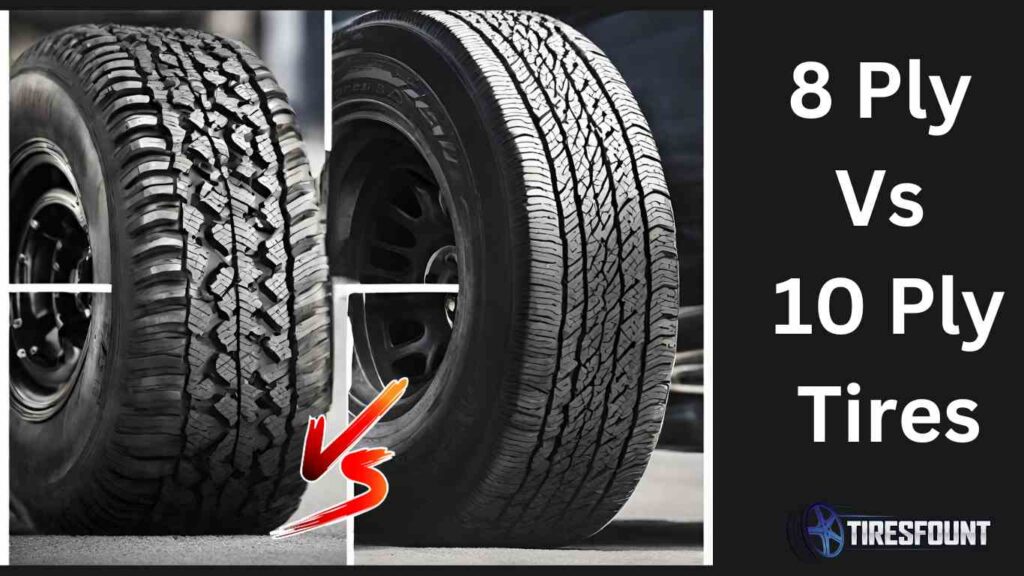In addition to their construction, 8 ply and 10 ply tires differ in terms of their load capacity and durability. These differences directly impact their performance and suitability for different vehicles.
Specifically, 8 ply tires are generally lighter and provide a smoother ride, whereas 10 ply tires, being heavier with heavy duty side walls. offer greater load capacity and higher resistance to punctures.
This makes them ideal for heavy-duty vehicles and challenging terrains.
And 8-ply tires are good, but they might look a bit flatter than fully pumped 10-ply ones.
In the subsequent sections of this article, I will further dissect these differences and their implications for your vehicle.

8 Ply Vs 10 Ply Tires: An Overview
Here is data that reflects the main differences between 8-ply and 10-ply tires.
This will give you enough data to get the main idea about them. But after this, a detailed discussion is added so that you can know more.
| Features | 8 Ply Tires | 10 Ply Tires |
| Designation | Light Truck (LT-metric), Load Range D | Light Truck (LT-metric), Load Range E |
| Plies (or Layers) | 8 plies or layers | 10 plies or layers |
| Maximum Pressure | Typically 65 psi | Typically 80 psi |
| Strength | Strong, with 8 layers of reinforced material | Very strong, with 10 layers of reinforced material |
| Weight Load | Can carry a significant amount of weight but less than a 10 ply tire typically | Can carry a higher weight load compared to an 8 ply tire |
| Ride Comfort | More comfortable, as they are generally softer | Less comfortable compared to 8 ply tires due to increased firmness |
| Fuel Efficiency | More fuel efficient due to reduced rolling resistance | Less fuel efficient due to an increased rolling resistance |
| Durability | Very durable but less so compared to 10 ply tires | Extremely durable and highly resistant to punctures |
| Cost | Less expensive than 10 ply | More expensive |
These features can vary depending on the specific brands or models of the tires. Always check tire specifications before purchasing.
Detailed Difference between 8 ply and 10 ply tires

These details are to give you additional data about the differences between these two tire types.
Plies or Layers
“Plies” refers to the layers of material within the tire. So, an 8 ply tire has eight layers while a 10 ply one has ten.
These layers can be made of different things – could be rubber, composite, steel.
They make the tire tough and affect how much weight the tire can handle. More layers, more strength!
Maximum Pressure
This is all about how much air pressure the tire can hold. And pressure equals carrying capacity.
8 ply tires can hold up to 65 psi, while 10 ply tires can go up to 80 psi. Higher psi means the tire can handle more weight.
Ride Comfort
Imagine bouncing on a trampoline. The more you tighten it, the less comfortable the jump, right?
Same with tires. The more layers or plies, the firmer the tire. So, an 8 ply tire offers a smoother ride than a 10 ply tire.
Weight Load
This is straightforward. 10 ply tires can carry more weight than 8 ply ones because of the extra strength from the additional layers.
They’re the heavy lifters of the tire world!
Durability
Both 8 and 10 ply ones are tough cookies. But with two more layers of material, 10 ply tires are even more resistant to damage and punctures than their 8 ply siblings.
It’s like having an extra suit of armor in a medieval battle, but for tires.
Cost
Just like with most things, more features or better performance usually means a higher price.
So generally, 10 ply tires are typically pricier than 8 ply ones. They’re built to handle tougher situations and heavier loads, after all.
Can I Use 8 Ply Instead Of 10 Ply Tire Or Vice Versa?
You can use one instead of another. There will not be any mistake if you do this.
However, before making the switch, there are a few things you really need to consider.
What you’re going to use your vehicle for?
If you’re hauling heavy loads, towing, or often driving off-road, then 10 ply tires might be the better choice because they are more durable and can handle more weight.
If your vehicle is mostly used for commuting or city driving, an 8 ply might be more than enough.
Your vehicle’s recommended tire specifications
Check your car’s manual or the label on the driver side door jamb to see the recommended tire size and load rating for your vehicle.
Ditching these recommendations could impact your vehicle’s handling, fuel efficiency, and even safety.
Fuel Efficiency
If you’re concerned with gas mileage, then 8 ply would be preferable. The increased rolling resistance of 10 ply tires can lower your miles per gallon.
Comfort vs Durability
Remember our chat about ride comfort? Well, if you’re all about a smooth ride, 8 ply is the way to go.
But if you want that extra fortification and don’t mind a stiffer ride, then 10 ply it is.
Tire pressure
With 10 ply tires, you can pump more air into them – so you get greater load capacity.
But, if you’re using those 10 ply tires at 8 ply pressures, just keep in mind, you might not get that increased load benefit you’re paying for.
8 Ply Vs 10 Ply Trailer Tires
If the trailer carries lighter loads and you’re keen on a smoother ride and fuel efficiency, go for 8 ply tires.
Are 10 ply tires more puncture-resistant?
If you’re hauling heavier loads and need puncture resistance and durability, especially for off-road use, opt for 10 ply tires, though they’re pricier and less comfy. Choose based on your needs!
8 Ply Vs 10 Ply Truck Tires
For trucks with lighter loads, passenger use, or regular city driving, 8 ply tires are ideal for their smooth ride, fuel efficiency, and lower cost.
However, if your truck frequently carries heavy loads, drives off-road, or needs stronger, more durable tires, 10 ply is the way to go, despite higher costs and lesser comfort.
The choice should match your truck’s demands.
Final Words
The tire choice between 8-ply and 10-ply hinges on the vehicle’s specific demands.
Contrastingly, 10-ply tires suit heavier vehicles, prioritizing durability, load capacity, and puncture resistance, making them ideal for trucks and SUVs. We have already compared 10 Ply vs 4 Ply tires.
For urban or suburban commuting with milder terrains, 8-ply tires offer comfort and efficiency.
Meanwhile, off-road adventures, heavy loads, or towing necessitate the robustness of 10-ply tires.
Choosing carefully ensures that you get long-lasting, safe, and top-notch performance.
